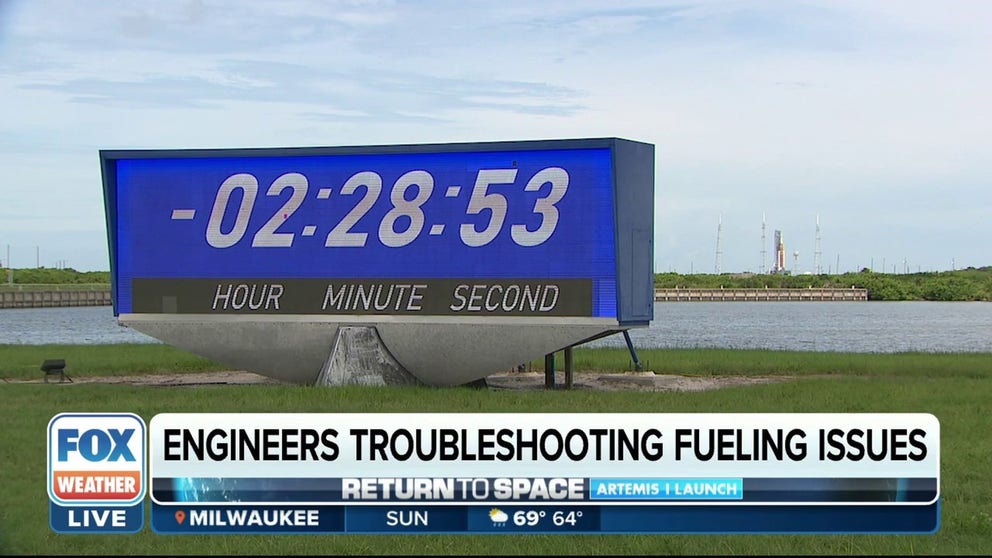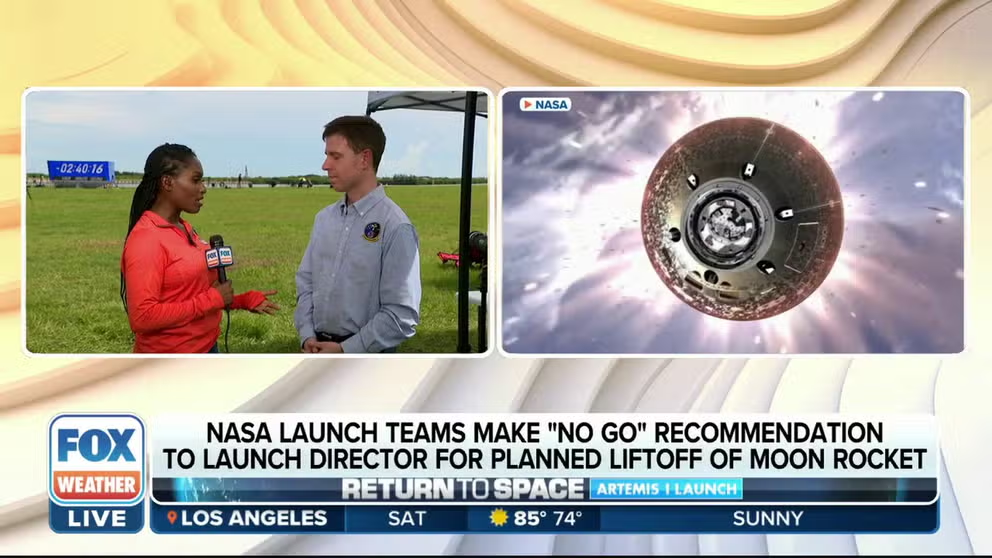‘We are not where we want to be': NASA leaders eye significant delays for Artemis I launch
A rocket engine cooling issue scrubbed Monday’s launch of the Space Launch System and Orion spacecraft and now NASA has called off a second attempt due to another technical issue.
Artemis launch could be weeks away while engineers troubleshoot issues
The Artemis launch was scrubbed again Saturday after an engine leak forced NASA leaders to postpone. FOX Weather's Brandy Campbell joins us live from the Space Coast to explain more.
KENNEDY SPACE CENTER, Fla. – NASA’s second try to launch its mega moon rocket ended in another scrub with mission leaders unsure on when the next attempt will take place.
The space agency tried to launch the Space Launch System rocket and Orion spacecraft on Saturday, but a large hydrogen leak was discovered hours before liftoff.
"We are not where we want to be," Jim Free, NASA's associate administrator for exploration systems development, said after the scrubbed launch attempt.
Launch Director Charlie Blackwell-Thompson gave the "go" to begin fueling the 322-foot-tall Space Launch System rocket began around 5:45 a.m. Over the course of the morning approaching the launch window, the rocket was set to be filled with more than 700,000 gallons of cryogenic liquid hydrogen and liquid oxygen propellant.
With the countdown clock ticking a liquid hydrogen leak led to a significant delay in fueling as teams worked to troubleshoot the issue.
Engineers stopped the liquid hydrogen flow to allow the connection to the rocket's core stage to warm up in hopes of fixing the leak. However, the first try of that method did not succeed and teams tried the same method again. After a third attempt to solve the problem Launch Director Charlie Blackwell-Thompson called a scrub for Saturday's launch attempt before 11:30 a.m.
NASA’s massive moon rocket remains on launchpad 39B at Kennedy Space Center, awaiting its maiden voyage but Free said the rocket stack would likely have to be returned to the Vehicle Assembly Building to undergo maintenance and address other issues.
WHAT IS NASA'S ARTEMIS 1 MISSION GOING TO DO?
"We'll go when it's ready," NASA administrator Bill Nelson said after the launch was called off. "We don’t go until then and especially now on a test flight, because we are going to stress this and test it, and test that heat shield and make sure it’s right before we put four humans up on the top of it."
The SLS will be rolled back to the VAB regardless of the next launch attempt unless NASA can get a waiver from the eastern range to remain on the pad.
A rollback to address needed repairs would likely cost several weeks putting any potential launch attempt in late October, at the earliest.
"The demeanor in the LCC [Launch Control Center] is very professional. They do their job. Naturally, all of us know no more than the LCC, wanted it to go today. But these guys that are the professionals know, it doesn't go until it's ready," Nelson said.
A detailed analysis of the available options and needed repairs is expected to be released by the space agency Labor Day week.
Saturday was take two for NASA
NASA launch teams make 'no-go' recommendation to Artemis 1 launch
A "no go" is different than a scrub. A scrub means no launch today, a no-go could be called by multiple people on the launch team, including weather officers.
NASA Artemis mission manager Mike Sarafin said the decision to move forward with a Saturday launch happened after reviewing the data following the first Artemis 1 launch attempt on Monday that ended in a scrub.
Several technical issues popped up while the SLS was being fueled with 700,000 gallons of cryogenic propellant during Monday's countdown.
After a lightning delay, Launch Director Charlie Blackwell-Thompson gave the "go" to begin fueling the SLS on Monday around 1 a.m. Several potential hydrogen leak issues cropped up during the countdown, but ultimately it was the engine temperature that caused the launch director to scrub the liftoff attempt just after 8:30 a.m. Monday.
"What held us up on our attempt on Monday was the fact that we got a late start due to the weather, and so then our tanking timeline pushed into the window, and then we had a technical problem that to resolve that technical problem required more time than what we had in the window remaining," Blackwell-Thompson said.
The technical issue was not the engine hardware, but the bleed system used to get the rocket engine to a very cold temperature. Engines 1, 2 and 4 were close to temperature, but engine 3 was not. This could be caused by a hydrogen leak or a sensor error, NASA managers said Tuesday. The SLS is fueled with liquid hydrogen, a tiny molecule that also created problems for the space shuttle program.
SLS program manager John Honeycutt said the four RS-25 engines on the SLS core stage should be chilled to minus 420 degrees Fahrenheit and engine 3 was about 30 to 40 degrees from hitting that mark. Engines 1, 2 and 4 were at minutes 410, so technically, none of the engines were at temperature.
Like race cars that won't go out on the racetrack without warming up, Honeycutt said rocket engines also need to be conditioned for the cold.
"What you want to do in a rocket engine system that uses hydrogen as a fuel and oxygen as an oxidizer is you want to need to establish a way to make sure you chill down the engines," Honeycutt said. "The way we do that is we send liquid hydrogen out of the hydrogen tank to each individual engine. It has its own bleed system, which is used to take the heat out of the engine as we chill it down."
To account for the issues during Monday's attempt, the engine chill process was set to begin about 35 minutes earlier in the countdown on Saturday. However, the launch team did not make it that far on Saturday to test this solution.

